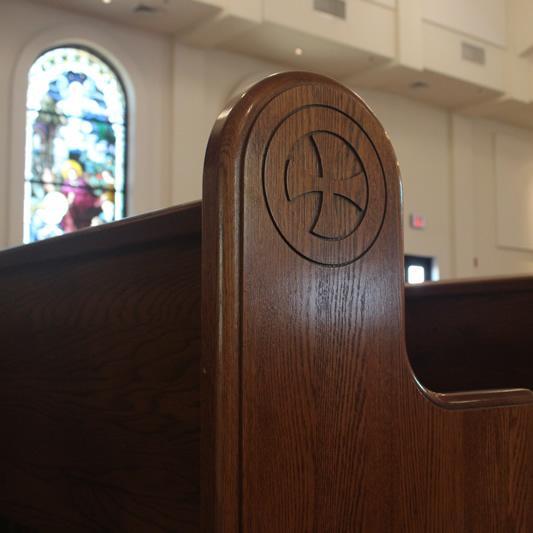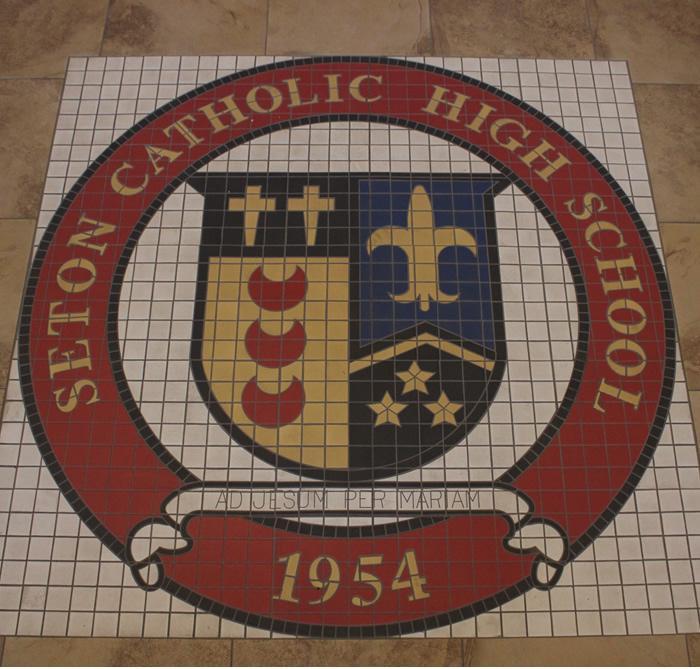The St. Elizabeth Ann Seton Chapel
We intend this chapel to reflect Mother Seton's life-journey as it led to her conversion to Catholicism and ultimately to becoming our Church's first American-born saint. We have attempted to incorporate her time in Italy, New York, Maryland, as well as the expanding Setonian movement on to Pennsylvania and finally Arizona.
About St. Elizabeth Ann Seton
Elizabeth Ann Seton, born in New York City in 1774, made her profession of faith and received the Eucharist in 1805 at St. Peter's Church, the first Catholic church in the state of New York. Her journal records that The Crucifix ion painting above the altar in St. Peter's was her "favorite." This painting, by renowned Mexican artist Jose Vallejo, was a gift from the archbishop of Mexico City in 1789. Our chapel crucifix will be modeled after that painting.
As wife, mother, teacher, and religious foundress, Elizabeth Ann Bayley Seton was a model for all walks of life. Born an Episcopalian in 1774, scripture and communion were bedrocks of her spirituality. ln 1794, she married wealthy businessman, William Seton, and was blessed with five children. For her work in providing for the poor, she and other prominent New York women were called "Protestant Sisters of Charity." When William's health and business failed, Elizabeth took him to Italy, hoping the Mediterranean climate would cure him but he died tragically while quarantined in Livorno. It was there, during her time of mourning, that Elizabeth discovered the Catholic faith through the example and teaching of the Filicchi family, her hosts and friends in Italy. The faith she saw lived there, led her toward a deep devotion to the Eucharist and so when she returned to America, she converted to the Catholic faith and became a social outcast among her wealthy Protestant friends.
In 1809, she adapted the rule ofthe Daughters of Charity, founded by Saint Vincent de Paul, and began the first American religious community, the Sisters of Charity. In 1810, at the invitation of Bishop John Carroll, the first Catholic bishop of the United States, Mrs. Seton went to Emmitsburg, Maryland to establish a school. Although Mother Seton died in 1821, paradoxically, she continues to be an active, vital force in the world today. Thousands of Sisters of Charity, with motherhouses in New York, Cincinnati, Halifax, Convent Station and Greensburg, serve the Church on almost every continent.
On September 14, 1975, Pope Paul VI declared, "Elizabeth Ann Bayley Seton is a saint," making her the first native-born American to be canonized.
Chapel Features
 The design on the altar, the ambo, the presider's chair and the ends of the pews is based on the emblem of the Sisters who have in some part served since the opening of the school in 1954. The emblem, designed by Sister Mary Francis Irvin, S.C., is an adaptation of the Celtic cross, surrounded by "Sisters of Charity of Seton Hill" and the congregation's motto: "The charity of Christ urges us."
The design on the altar, the ambo, the presider's chair and the ends of the pews is based on the emblem of the Sisters who have in some part served since the opening of the school in 1954. The emblem, designed by Sister Mary Francis Irvin, S.C., is an adaptation of the Celtic cross, surrounded by "Sisters of Charity of Seton Hill" and the congregation's motto: "The charity of Christ urges us."
The first class relic of Saint Elizabeth Ann Seton in the altar was the generous gift of Father Frank Bartel, pastor of Saint Elizabeth Seton Parish in Sun City.
The dome is reminiscent of many ltalian churches, such as Santa Catarina da Siena in Livorno, where Elizabeth Ann Seton spent many hours praying as she tried to discern conversion.
The antique Zettler stained glass windows, made in Munich, depict the five Joyful Mysteries of the Rosary and the Descent of the Holy Spirit at Pentecost. The windows, as well as the major portion of the funding for the chapel, were lovingly donated by Mrs. Lorenza DeMuro, in memory of her late husband, Samuel.

Statues of our Blessed Mother and St. Joseph adorn each side of the altar The rose window above the altar, designed by Seton Catholic art students, depicts a chalice and a host, emphasizing Mother Seton's deep-seated devotion to the Real Presence in the Blessed Sacrament. The window was donated by Mr. and Mrs. Gene DeMuro.
While Elizabeth was in Italy, the Filicchis gave her a painting of Our Lady of Guadalupe, which became very dear to her. The picture of Our Lady of Guadalupe, which hangs in the rear of the chapel, was donated by Rev. Fred Adamson, V.G., Vicar General, Moderator of the Curia, Diocese of Phoenix.
A statue of St. Vincent de Paul. He founded the Conference of Charity (an association of women of rank and wealth who aided the poor and the sick,) the Congregation of the Mission (Vincentians, founded for the preaching of missions to the poor and the training of seminarians) and, with Louise de Marillac, the Daughters of Charity (poor country girls who served the poor.) His influence on lTth C. France, as well as on the centuries following, is inestimable. ln God's providence, Vincent was to be the soul of Mother Seton's community.
Seton's Coat of Arms
 The origins of Seton Catholic High School are effectively symbolized in our coat-of-arms, beautifully laid in tile on the floor of the chapel narthex. The three crescents were taken from the Seton family emblem. The two crosses were adapted from the missionary cross in the coat-of-arms of the Diocese of Tucson (in which Seton belonged until the Diocese of Phoenix was established in 1969). The star in the Arizona state flag became triple stars indicating the Blessed Trinity, while the fleur-de-lis represents Mary, our mediatrix, as expressed by the inscription: 'To Jesus through Mary." The chevron, standing for the gable of God's house, reaches up into the blueness of our Arizona sky. The crest carries the school colors – red and gold – blazoned on a base of blue, for Mary; and black, the color of the Tucson diocesan arms.
The origins of Seton Catholic High School are effectively symbolized in our coat-of-arms, beautifully laid in tile on the floor of the chapel narthex. The three crescents were taken from the Seton family emblem. The two crosses were adapted from the missionary cross in the coat-of-arms of the Diocese of Tucson (in which Seton belonged until the Diocese of Phoenix was established in 1969). The star in the Arizona state flag became triple stars indicating the Blessed Trinity, while the fleur-de-lis represents Mary, our mediatrix, as expressed by the inscription: 'To Jesus through Mary." The chevron, standing for the gable of God's house, reaches up into the blueness of our Arizona sky. The crest carries the school colors – red and gold – blazoned on a base of blue, for Mary; and black, the color of the Tucson diocesan arms.